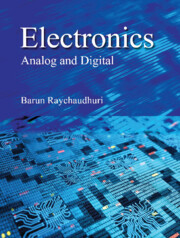Book contents
Summary
This chapter introduces the construction and working principle of n–p–n and p–n–p transistors with proper discussion on common-emitter, common-base, and common-collector configurations. The amplifying action of the device is explained. The device is formally termed as bipolar junction transistor (BJT) because both electrons and holes, the charges of two opposite polarities take part in current conduction. There is yet another type of transistor, known as field-effect transistor (FET) that is unipolar; consisting of charge carriers of a single polarity, electrons or holes. Such devices will be illustrated in Chapter 9. Unless otherwise stated, the word ‘transistor’ refers to the BJT throughout this book.
Transistors: n–p–n and p–n–p
A transistor is made of semiconductor, mostly of silicon in present days. Two types of constructions are possible, either a p-region sandwiched between two n-regions or vice versa, as sketched in Figures 5.1 (a) and (b). These devices are termed as n–p–n transistor and p–n–p transistor, respectively. The corresponding circuit symbols are also given in Figure 5.1. The construction of both types of transistors includes the following stipulations.
(i) The transistor has two p–n junctions and three distinct regions, namely emitter, base, and collector. These regions have different sizes and doping concentrations.
(ii) The emitter is heavily doped. It injects carriers into the base: electrons for n–p–n transistors and holes for p–n–p transistors.
(iii) The base is very thin (a few percent of the total device width) and lightly doped. It allows the recombination of a small fraction of the carriers injected from the emitter and the passage of most of the carriers through it toward the collector.
(iv) The collector is the largest in size and of moderate doping; often the lightest among the three regions. The carriers crossing the base are collected in this region. The collector–base junction area is made to be maximized.
(v) A metallic ohmic contact is made with each region for applying external bias voltages.
Transistor Operating Principle
The transistor came forth as the first semiconductor device that could reproduce the major characteristics of electronic devices obtained earlier with vacuum tube devices (such as triode and pentode), namely
• electrical power amplification,
• nonlinear current–voltage relationship, and
• different input and output impedances.
- Type
- Chapter
- Information
- Electronics , pp. 141 - 162Publisher: Cambridge University PressPrint publication year: 2023



